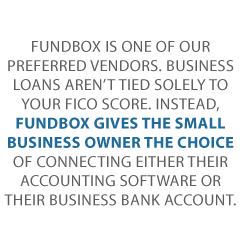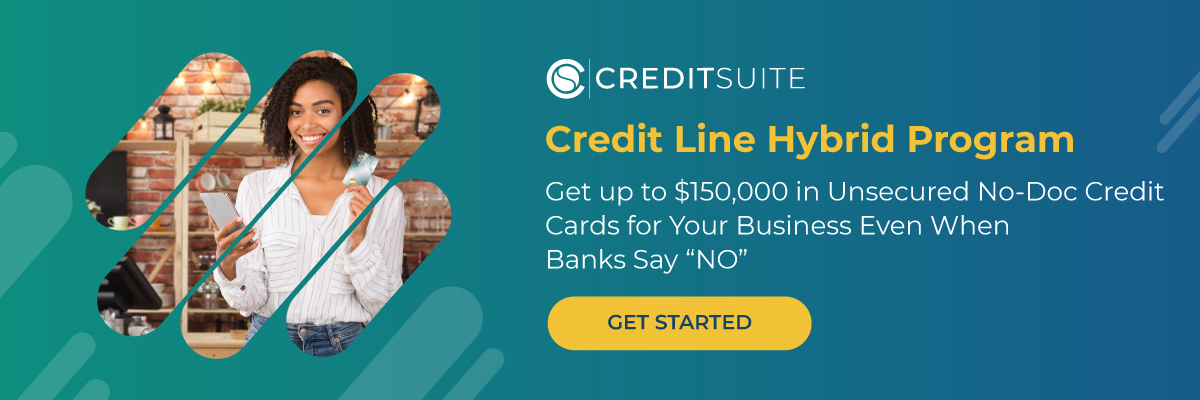Fundbox Credit Line
Find out about a Fundbox credit line.
On November 28, 2017, we interviewed Greg Powell at Fundbox about the topic of the evolution of small business credit … and why you should care!
A Bit About Fundbox
Fundbox is one of our preferred vendors. Business loans aren’t tied solely to your FICO score. Instead, Fundbox gives the small business owner the choice of connecting either their accounting software or their business bank account.
It then reviews those data sources (plus FICO scores in some cases), using AI in order to better understand their business. Credit decision are based upon that information.
This is somewhat unique; it’s one of the only credit lines that don’t rely solely on a credit check and tons of personal information. This is the opposite of most credit lines; they usually require good personal credit and many additional documents like tax returns.
However, if you choose to supply tax returns, you can get approved for even more money.
This differs from many other credit lines; that may require good personal credit and many additional documents like tax returns.
Small Businesses Together Wield Big Influence
Small businesses make up a huge market – but they have commonly cash flow gaps. They provide nearly half of all American private sector employment and make up over 97% of all United States businesses!
These two facts mean that small businesses are a huge engine for the entire US economy.
However, in total, small businesses are holding over $825 billion in unpaid invoices. This works out to a good 5% of American gross domestic product, and it means that small businesses, on average, are holding a good $84,000 in unpaid invoices.
As one might expect, these cash flow gaps create big headaches for small businesses, since just because their invoices aren’t being paid does not mean that expenses such as rent and payroll grind to a halt.
What Makes Cash Flow Gaps So Common?
One big reason has to do with how credit is distributed to small businesses in the US.
Banks
Banks are a popular option. They make their decisions with the help of a manual underwriter. With a number of steps being handled manually, the process gets bogged down. This means that it takes just as long to review a request for a $10,000 loan versus a $1,000,000 loan.
Of course, the banks’ main goal is that they want to minimize risk. This is why they will inspect your personal credit score which means they are looking at your FICO score. It’s also why they will ask for a personal guarantee.
And they will also judge your risk level based on your account balance – but if you didn’t have an account balance that was lacking, you wouldn’t be seeking a bank loan in the first place.
A cash poor business is often going to be the kind of business looking for a loan. Even successful businesses can be cash poor, and that counts against your business when you’re looking to get a bank loan.
Things have been this way for a good five decades (ever since FICO was created), and not just with the banks. This is also how business credit cards are handed out. This makes sense as business credit cards are tied back to a bank.
2008 and its Aftermath
It was the perfect storm. The housing market collapsed. Banks lost money due to bad investments and, as a result, all credit froze.
And then the federal government stepped in and passed the Dodd-Frank bill. Banks became required to hold onto higher reserves in order to lower their risk of insolvency.
This hit small businesses very hard. From 2011 to 2013, only about 13% of all small business loan applications were granted. This has slowly risen to 25% in 2017. Hence there are rejections for three out of four loan applications by small businesses.
This is because, with their higher reserves, banks could no longer profitably lend less than $100,000 to any given small business.
The Issues
This can be a real problem. Working with a bank can be a slow process; it can take up to 30 hours to apply before most small business owners will find a bank willing to lend to them.
And then, on top of that, it’s another 60 – 90 days to get an approval if you’re looking to get a loan from the Small Business Administration, as they have more rigorous standards.
Plus banks treat small business owners a lot like consumers. This makes it more difficult to separate consumer and commercial finances.
It also serves to effectively punish you for bootstrapping with personal loans or if there are too many inquiries on your personal credit (too many inquiries can lower your consumer credit scores). Inquiries can even reduce the amount you can borrow.
Furthermore, there’s that same $100,000 minimum – this is problematic if you need less.
Fintech (Financial Technology)
The first wave of Fintech was when entrepreneurs figured out how to handle some of the more manual parts of underwriting online. These online applications and rules-based decisions made the process go more smoothly.
As a result, more small businesses got the funding that they needed.
However, it can still be a few days before you get a credit decision. There can be hidden fees. And even Fintech still treats small businesses and their owners like customers, so there are still consumer credit inquiries.
Fundbox Credit Line: New Ways to Solve Older Problems
There is yet more data in the cloud now. This means that you have more options and control than ever before. As a result, a new wave of entrepreneurs has figured out how to:
- Make credit decisions without resorting to reviewing FICO scores
- Provide you with more control over the data you share, and when
- Offer greater transparency when it comes to fees and only charge you upon the withdrawal of funds. There are no inactivity fee charges
- Provide incentives for responsible behavior by rewarding prompt and early payments
Fundbox Credit Line Rates
Fundbox pricing is based on the ‘drawn value’. Fees start at 4.66% of the drawn value, paid over 12 weeks. This is close to 3% less than what we have seen with SBA loans. In fact, these are the lowest rates we have seen within the business credit line space.
There are no fees unless you draw funds, and they do not make borrowers draw funds. It can work somewhat like a ‘rainy day fund’ with no inactivity fees or subscription fees. This is rare!
They can offer a credit line of as large as $100,000 or as small as $1,000.
https://creditsuite.wistia.com/medias/tzam7150ub?embedType=async&videoFoam=true&videoWidth=640
Getting a Fundbox Credit Line: The Process
Through the Credit Suite link at https://www.creditsuite.com/fundbox, it’s only a few questions and then you can be immediately approved. You get access to your credit line in about 24 hours.
It only takes a few hours (generally one to three) to get a credit decision after you have connected your software. Funds transfer as soon as the next business day.
What They Look For
Fundbox credit line requirements – they look for healthy businesses. This means with accounting software, they want to see a lot of receivables, invoices going out, with healthy revenue.
If you’re showing your bank account, they want to see healthy transactions. They are generally looking for around $50,000 or more in a bank account. Also, they are usually looking for a minimum of three years in business.
They also want to see several transactions with a variety of customers.
For companies with a minimum of one year in business, they want at least three months’ worth of transactions – you could qualify. Fundbox does want to see a positive history in your accounts.
This is enough for their process – if your accounting software or bank accounts show this, then it can be enough.
Fundbox in particular offers smaller credit lines. As has been our experience, a lot of small business owners need far less than the $100,000 minimum required by banks, and Fundbox can accommodate them.
Fundbox can also accommodate small business owners’ needs for urgent funding for goals such as meeting payroll.
Tips to Keep in Mind for a Fundbox Credit Line
- Business merit instead of personal credit – you have a choice as to whether you want to share your personal credit. This decision is important and it has implications. Do you want a lender to judge your business on its merits or on your personal credit?
- Timing – consider just when you will need the funds. How much time are you willing to spend filling out an application?
- Fees – what do they cover? What are the hidden costs?
- Credit limit – just how much credit do you really need? You don’t want to be paying for money that you do not need
- Control over data – your information is an asset; you should be the one with control over it
Got Questions?
You can find out more about a Fundbox credit line by going to https://www.creditsuite.com/fundbox. If you’ve got questions for Greg, you can contact him at [email protected]. Check out how a Fundbox credit line will help your company.
And for more updated information go to our newer Fundbox article with updated research.

